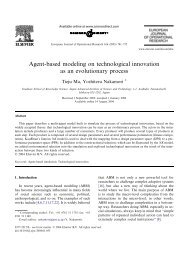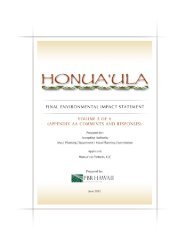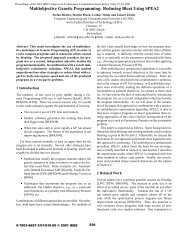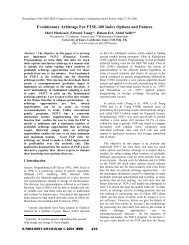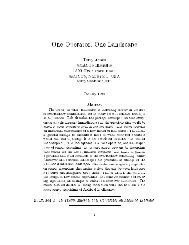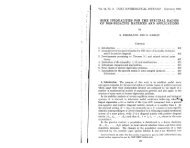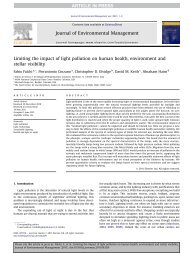draft eis comments and responses - Lee Altenberg
draft eis comments and responses - Lee Altenberg
draft eis comments and responses - Lee Altenberg
You also want an ePaper? Increase the reach of your titles
YUMPU automatically turns print PDFs into web optimized ePapers that Google loves.
Environmental Center<br />
SUBJECT: HONUAÿULA DRAFT ENVIRONMENTAL IMPACT STATEMENT AND PROJECT<br />
DISTRICT PHASE II APPLICATION<br />
May 31, 2012<br />
Page 17 of 23<br />
Section 7.2 (Cumulative <strong>and</strong> Secondary Impacts) will be revised as follows<br />
In mitigating cumulative impacts to human <strong>and</strong> environmental health, Honua‘ula is<br />
committed to limiting energy consumption <strong>and</strong> reducing solid waste. Honua‘ula<br />
Partners, LLC will design <strong>and</strong> construct energy systems for all residential units to meet all<br />
applicable ENERGY STAR requirements established by the EPA in effect at the time of<br />
construction. All homes (single-family <strong>and</strong> multi-family) will be equipped with a primary<br />
hot water system at least as energy efficient as a conventional solar panel hot water<br />
system <strong>and</strong> other energy-saving concepts <strong>and</strong> devices will be encouraged in the design<br />
of Honua‘ula.<br />
Section 7.2 (Probable Adverse Environmental Effects that Cannot be Avoided) will be<br />
revised as follows<br />
All homes (single-family <strong>and</strong> multi-family) with be equipped with a primary hot water<br />
system at least as energy efficient as a conventional solar panel hot water system <strong>and</strong><br />
other energy-saving concepts <strong>and</strong> devices will be encouraged in the design of<br />
Honua‘ula.<br />
Question/Comment: Roof <strong>and</strong> wall insulation, radiant barriers, <strong>and</strong> energy efficient windows.<br />
This is vague – what R factor insulation in walls <strong>and</strong> ceiling? Which type of energy efficient<br />
windows? There is insufficient detail to determine if this will make a big difference.<br />
Response: Section 4.8.6 (Electrical System) of the Draft EIS mentions that energy saving methods<br />
<strong>and</strong> technologies, such as roof <strong>and</strong> wall insulation, radiant barriers, <strong>and</strong> energy efficient windows,<br />
will be considered during the design phase of Honua‘ula. At this time Honua‘ula Partners, LLC<br />
has not undertaken detailed building design <strong>and</strong> thus building specifications such as installation R<br />
factors <strong>and</strong> the type of energy efficient windows that may used are not known at this preliminary<br />
point.<br />
Question/Comment: Solar parking lot lighting. This is good but we would add that they use only<br />
IDA approved fixtures (International Dark Sky Association)…<br />
Response: As explained in several sections of the Draft EIS (see Section 3.7 (Wildlife Resources),<br />
Section 5.2.1 (Countywide Policy Plan), <strong>and</strong> Section 5.2.3 (County of Maui Zoning)), all<br />
Honua‘ula outdoor lighting will be in compliance with Chapter 20.35 (Outdoor Lighting), Maui<br />
County Code to ensure impacts related to light pollution will not impact sensitive surrounding<br />
l<strong>and</strong> uses.<br />
Question/Comment: Light color roof. It makes a huge difference but saying light color is not<br />
enough. It should be tied to some st<strong>and</strong>ard like the California st<strong>and</strong>ard for roofs.<br />
Response: Section 4.8.6 (Electrical System) of the Draft EIS mentions that energy saving methods<br />
<strong>and</strong> technologies, such as the use of light color or “green” roofs, will be considered during the<br />
design phase of Honua‘ula. At this time Honua‘ula Partners, LLC has not undertaken detailed<br />
building design <strong>and</strong> thus building specifications such as st<strong>and</strong>ards for light color or “green” roofs<br />
that may be used are not known at this preliminary point.<br />
Environmental Center<br />
SUBJECT: HONUAÿULA DRAFT ENVIRONMENTAL IMPACT STATEMENT AND PROJECT<br />
DISTRICT PHASE II APPLICATION<br />
May 31, 2012<br />
Page 18 of 23<br />
Question/Comment: Roofs <strong>and</strong> gutters to divert rainwater for l<strong>and</strong>scaping. This is fine but they<br />
should specify storage tanks size for this rainwater or how it was going to be retained/absorbed<br />
<strong>and</strong> not become run off (i.e. use of rain gardens or bioswales, etc.)<br />
Response: Section 4.8.6 (Electrical System) of the Draft EIS mentions that energy saving methods<br />
<strong>and</strong> technologies, such as the use of roof <strong>and</strong> gutters to divert rainwater for l<strong>and</strong>scaping, will be<br />
considered during the design phase of Honua‘ula. At this time Honua‘ula Partners, LLC has not<br />
undertaken detailed building design <strong>and</strong> thus building specifications regarding rain gutters,<br />
rainwater storage tanks, <strong>and</strong> rain gardens, that may be used are not known at this preliminary<br />
point.<br />
Question/Comment: Use of photovoltaics, fuel cells, <strong>and</strong> other renewable. This is vague <strong>and</strong><br />
sounds like a dreamer’s list. We would rather see the developer place a 6 kw photovoltaic system<br />
on each home.<br />
Response: Section 4.8.6 (Electrical System) of the Draft EIS mentions that energy saving methods<br />
<strong>and</strong> technologies, such the use of photovoltaics, fuel cells, <strong>and</strong> other renewable energy sources,<br />
will be considered during the design phase of Honua‘ula. At this time Honua‘ula Partners, LLC<br />
has not undertaken detailed building design <strong>and</strong> thus building specifications regarding<br />
photovoltaics, fuel cells, <strong>and</strong> other renewable energy sources that may be used are not known at<br />
this preliminary point. We note that photovoltaic systems <strong>and</strong> other renewable energy systems<br />
are an emerging technology. Specifying a specific system with a specific energy output at this<br />
time does not seem wise or warranted as the technology may change significantly over the buildout<br />
period for Honua‘ula.<br />
Question/Comment: We would also like to see the developer take these measures:<br />
Right-sized AC systems (not over-sized) with tight duct work that does not pass through<br />
unconditioned space (i.e. attic) unless the duct itself is insulated. This is specified in LEED.<br />
Zoned AC with programmable thermostat.<br />
Install an energy feedback device for the home owner, such as a TED (The Energy<br />
Detective) which can also be wired to monitor the PV production. The occupant can<br />
monitor their energy use, see when the watts spike up <strong>and</strong> adapt their behavior if they<br />
want to reduce their power bill.<br />
Response: In response to your comment, in the Final EIS Section 4.8.6 (Electrical System) will be<br />
revised as follows:<br />
The following additional energy saving methods <strong>and</strong> technologies will also be considered<br />
during the design phase of Honua‘ula:<br />
Use of site shading, orientation, <strong>and</strong> naturally ventilated areas to reduce cooling load;<br />
Maximum use of day lighting;<br />
Use of high-efficiency compact fluorescent lighting;<br />
Exceeding Model Energy Code requirements;<br />
Roof <strong>and</strong> wall insulation, radiant barriers, <strong>and</strong> energy efficient windows;<br />
Use of solar parking lot lighting;<br />
Use of light color or “green” roofs;



